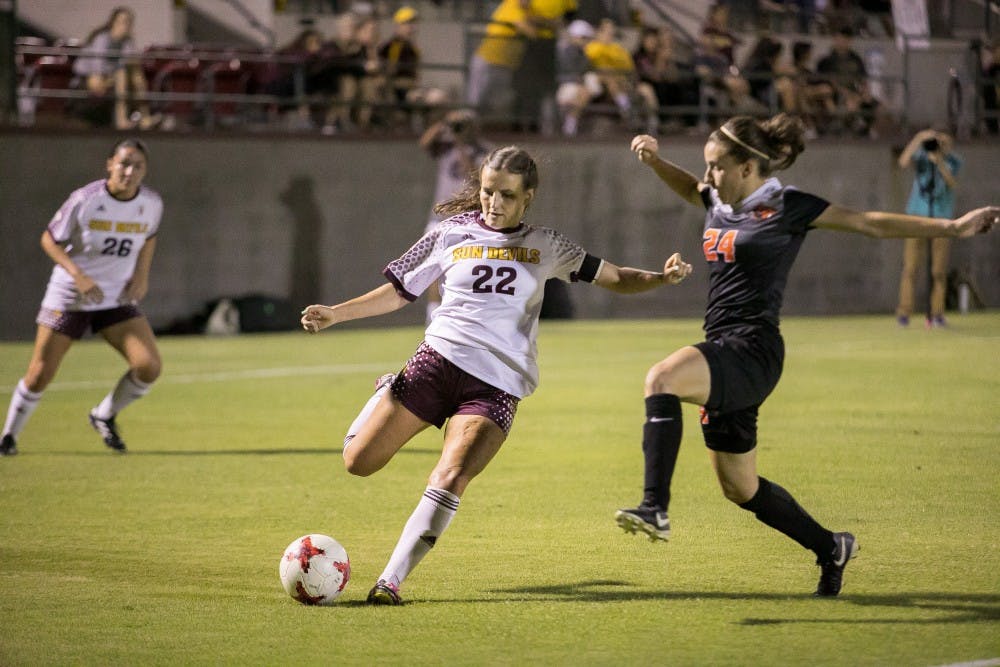The final whistle blows and the ASU women's soccer team congregates at the south corner flag to begin their post-game regeneration routine.
As the team stretches, some of the athletes begin to reach underneath their jerseys to remove the small pods secured in their athletic vests.
These obscure objects are part of Catapult’s wearable tracking device and heart rate monitor.
This wearable technology from the Australian sports analytic company includes an athletic vest and a pod that collects data for the athletes that wear it.
Blake Whitney, the Sun Devil's graduate assistant sports performance coach, closely follows the movements of his players from a laptop.
The Catapult technology records acceleration, deceleration and change of direction, among other things.
What makes this technology unique is that it gathers data from each individual athlete and calculates the intensity of a training session or game with a single numerical value. This metric quantifies something as subjective as work rate and gives a value known by Catapult as “Player Load.”
According to the Catapult website, the goals for this technology are to keep elite athletes from overtraining, help maximize performance and prevent injuries.
Both the heart rate monitors work together to give Whitney an overall picture of how each player is reacting to certain physical strains in practices and games.
"Now what that gives us is their heart rate data gets transmitted to the pod on the back of their neck," Whitney said. "It gives us a player load score for their heart rate ... We also see how far they cover, so their meterage, their meterage per minute in practice and in games."
Catapult pods collect an extensive amount of data from each player, yet Whitney explained that other than player load, he looks out for internal load, external load and the session’s rate of perceived exertion (RPE), to determine how the players are coping over the span of a grueling collegiate season.
“Their internal load is going to be their heart rate score, and we also get their session RPE scores at the end practice,” Whitney said. “External load is the amount of physical work they’re doing actually on the pitch — that’s going to be their total distance, how far they are running, how fast they’re running, how many high-speed movements they had.”
As much as this data is useful, some coaches and organizations are faced with the question of how much should they allow technology to dictate training sessions and matches.
In the case of ASU women's new coaching staff, Whitney explained that head coach Graham Winkworth was excited to use the Catapult technology and heart rate monitors.
"Last year I feel like we really didn’t use them for their purpose. I feel like we just wore them," sophomore holding midfielder Devyn Kelsey said after training.
Using this data, Whitney determined whether players' bodies have recovered enough for the strain of certain drills.
"Sometimes he (Whitney) will walk up to them and tell the coach these players need to sit out of this drill because their heart rates were too high," Kelsey said.
Conversely, in a match, Whitney will approach Winkworth with data, but rather than the data being vital to any in-game changes, it serves a more useful post-game tool for a more effective recovery.
Senior captain right back Madison Stark explained that she is aware of the numbers, but unlike in practice she is not fixated on the data while she is competing in a match.
"The number in practice and in games are looked at, but in a game you’re not worried," Stark said. "It doesn’t matter what your numbers are ... Its more after the fact ‘what are we gonna do about that? How are we going to approach the next practice?'"
Catapult currently has over 50 other universities that use its technology. Despite it becoming common within the collegiate ranks, Whitney explained that it still provides an advantage for Sun Devil soccer.
"At the very least, it is giving us a competitive edge to ourselves to avoid injury, to avoid the over use and over training," Whitney said. "It’s definitely helping us stay healthy, which is gonna help us win games."
Reach the reporter at jaramo12@asu.edu or follow @hor_hay10 on Twitter.
Like State Press Sports on Facebook and follow @statepresssport on Twitter.




